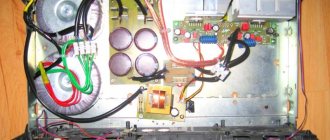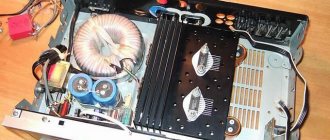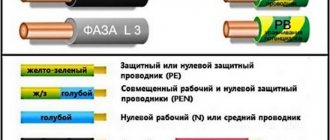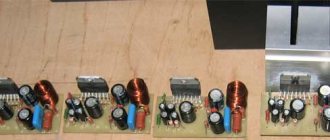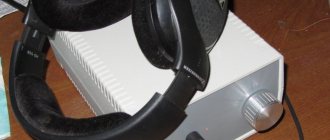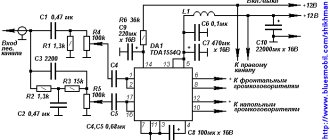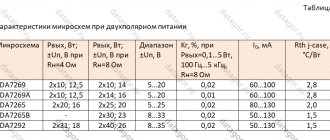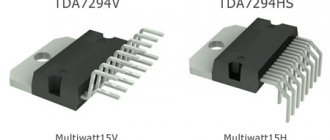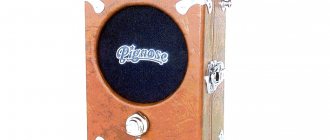According to the technical specifications, the TDA7388 chip is a four-way class AB audio amplifier with a maximum output power of up to 41 W per channel with a load of 4 ohms. Developed specifically for car radios by ST Microelectronics. The device allows you to create audio systems with a minimum set of electronic components. Ready-made modules based on it and constructors for do-it-yourself assembly are widely available on sale.
The TDA7388 is sometimes called a sound processor. It is positioned on the market as a budget version. The price of the device in Russia starts from 200 rubles. Quite often found in standard car audio systems, various radios and radios. Very popular among manufacturers of inexpensive equipment. But today it is difficult to surprise the spoiled consumer with its sound quality. Therefore, many people specifically buy such systems and then solder the amplifier to a more powerful and more expensive analogue like the TDA7850.
Car radios and TDA7850 TDA7560 TDA7388 PLA007 STPA003
Dear readers, I was inspired to write this post by the lack of up-to-date information about amplifier chips in radio tape recorders.
After purchasing an Android 2din radio (Witson A430), I was disappointed with the quality of its sound and a quick google turned up a bunch of articles about replacing the TDA7388 with a TDA7850 + increasing the capacitance of the capacitor that is in the power circuit of this microcircuit. After the replacement, the sound quality did not change much. I was upset in view of the huge number of positive results here on the drive. Then I was puzzled by searching for the “original” microcircuit. We even soldered PAL007 from an old Pioneer radio. It's not the same. Then I started studying the manuals and all the available information from the manufacturer. Imagine my surprise that the TDA release of the entire series was glossed over and a new series STPA001 STPA003 STPA005 was released instead
STPA003 was ordered and the waiting time began.
After installation, the sound quality improved, but again not the same. After further study of the manuals, it was decided to change the wiring of the amplifier and tone block/mixer (BD37033), because The Chinese used ceramic capacitors and managed to mess things up with the inputs of the BD37033. The capacitor ratings at the input did not match + there was some kind of filter in the form of a pass resistor to the ground. The capacitors were replaced with film capacitors; everything superfluous was successfully removed. This procedure was done for the processor and radio inputs, AUX was not touched. Because the processor was connected via a balanced input, I had to look for its signal ground separately and change the capacitor on it, which by the way was 10 µF instead of 1 µF.
The audio output was also turned off, except for the subwoofer output, and the feed-through capacitors were removed.
After the manipulations were done, the sound quality began to change dramatically for the better. On the plus side, the overall volume has not increased much.
Separately, I would like to say about the capacitors at the STPA (TDA) input: they can be set in the range from 0.2 to 0.1 µF, the cutoff frequency at low levels will change. Without looking, I would recommend 0.2 for 20cm speakers, 0.15 for 16cm. and 0.1 for 13cm and less.
Bottom line: Replacing capacitors in the audio path gives the most noticeable result on sound quality. Replacing the Chinese TDA lottery, somewhere the tops are raised, somewhere the bottoms are overwhelmed, they all have great non-linearity. PAL007 can only be used if soldered from old radios, otherwise you will get a relabeled TDA. In general, replacing the amplifier microcircuit does not give any significant effect unless there is absolutely crap in there.
Source
Analogs
In search of better sound, audiophiles are looking for an analogue for the TDA7833. It is believed that this is due to the lack of clean high frequencies and “soft bass” in this microcircuit. It can be replaced in acoustic systems, without changing the binding components, with better parameters and at the same time more expensive: TDA7560, TDA7850, TDA7851. Also suitable as a replacement: pal007, tda7381, tda7384, YD7388. In this case, it is necessary to check that the pinout of these devices is identical.
How to replace tda7388 with tda7850 in Chinese radios is presented in the following video.
DataSheet for the tda7388 amplifier in pdf can be downloaded from the link.
Replacing the TDA7388 amplifier with a TDA7850
The topic of car audio is a complex thing, for some people it is necessary to be heard throughout the entire street, but for others a standard radio playing in the background is enough. So, I personally am closer to the latter, especially since in previous cars I played enough with amplifiers and subwoofers, but exclusively at the amateur level, nothing more.
The Chinese GU came into focus to replace the standard Sony. The main reason for the change was the presence of USB, and of course a nice addition - all sorts of applications and the ability to connect a rear view camera and a recorder.
As for the sound of Chinese GU. In comparison with Sony, the sound picture is clearly no worse and I personally found it even more interesting if I adjusted the equalizer to my liking. But the volume is clearly lower, and even when it reaches its maximum value, distortion begins, in the form of wheezing in the speakers. And it’s not their fault, because Sonya plays normally.
After reading all sorts of forums, the decision was made to change the output amplifier to a more powerful and high-quality TDA7850. Before this, I, of course, opened the GU and discovered the tda7388 chip, which is installed on most cheap radios. By the way, you can not open it, but measure the resistance of the speaker outputs, and if it is less than 2.92 kOhm, then most likely it’s worth a tda7388 or its equivalent with similar characteristics.
About purchasing the TDA7850 chip. Here, as usual, the main thing is not to run into a fake, so as not to say later that this is all complete crap and does not give anything! I resoldered it twice, since the first time I took a microcircuit with a resistance, as some sources on the Internet said, somehow vaguely, in the region of 3 kOhm. More precisely, mine showed 3.06. So after soldering it in, the sound became louder, but first one channel began to rustle and wheeze, and the next day the second. Everything was soldered clean and even. Into the furnace...
I almost forgot to say that in addition to the microcircuit, we also need to change the capacitor. I had a 25V 4700uF, replaced it with a 25v 10000uF. About capacitor companies is also a separate topic, but unfortunately, in my city, I can’t find anything worthwhile in stock, so for now I installed something Chinese.
So, after the replacement: - the sound became louder and without distortion, at the maximum volume possible for this GU. The speakers are standard blue. Moreover, sony is louder, butt meter); — the bass became deeper, the vibration in the chair became clearly stronger); — the overall feeling of the sound picture is cleaner. I would even say that now you can hear the difference in the sound of different formats. Mp3 320kbps now sounds, roughly speaking, like a good cassette, in comparison with flac and ape, and even more so with audio CD (CDDA). I’ll probably join the camp of those who think that the sound has become better after replacing the amplifier, especially since the price is around 500 rubles.
I was also overcome with interest to see what and how it works inside the standard Sony)
Source
Basic device parameters
Parts are selected based on the number of channels and amplification class. Having determined these parameters, you will be able to select a suitable device or make it yourself based on the TDA7388 chip.
Gain class
This indicator determines the level of signal distortion. For automotive devices, amplifiers come in 5 classes:
- A. Their efficiency does not exceed 20%, but the sound is less distorted after installing such devices. It is worth considering that they consume and release a lot of energy, so they are not suitable for every car. They are quite noisy. They are not installed in the cabin so as not to constantly listen to the hum of the device.
- B. According to their characteristics, they are more powerful, but they give a slightly distorted signal. Sound reproduction performance is more stable here, and thermal performance also remains at the same level. Devices of this class are usually larger in size.
- C. The efficiency reaches 75%, but the signal is greatly distorted when passing through the amplifier. Not suitable for all audio systems.
- D. This includes compact digital devices with clear sound. Previously they were only used for low frequencies, but have now become more practical.
There is also a mixed class AB, which includes durable devices with a decent sound level. Their efficiency does not exceed 60%, but this is enough. High power devices take up a lot of space and should not be installed in an enclosed space, otherwise the risk of short circuits and fire increases.
For drivers who value sound quality most, class AB devices are more suitable. For those who want to have a loud system inside the car, class D amplifiers are suitable.
Number of channels
Amplifiers with a built-in processor have a different number of power channels. Service station technicians believe that ideally each speaker has its own channel, but here, too, a lot depends on preferences.
Amplifiers have up to 6 power channels:
- Monoblock is used for subwoofers; they are installed when there is a low load. Single-channel amplifiers are produced in class D, they have a crossover with a low range and an external volume control. Suitable for standard radios that do not have a subwoofer.
- Two-channel devices are used for multiple speakers. They are equipped with a bridge circuit or a coil if there is enough power.
- They are rarely used, only where there are 2 channels for acoustics and a subwoofer. They are considered not very practical and reliable.
- Four-channel amplifiers are the most common. There are several options for their use, they are sold at a low price and are reliable. These amplifiers are considered more practical because any connection method produces good sound. To create an acoustic system, they are combined with two-channel devices.
- They are compact, but are not used very often. Suitable for 4 speakers and a subwoofer. Space is saved due to the fact that one device is used for several purposes at once.
Replacing the TDA7388 audio amplifier with a TDA7560 in the MMC DATSUN (push-button)
Hello friends! I once read from Grantovodov that they resolder the “TDA7388 power amplifier” in their MMC with a display to improve sound quality. Actually, it caught fire for me too))) I decided to rummage through our push-button MMC “Datsun” to find out what kind of microcircuit it costs. Many people know how to remove the radio, so I won’t describe it (the cladding is removed from the latches and the 4 screws that secure the radio are unscrewed...) It’s not difficult to disassemble the MMC, I’ll show you with my own example...
We didn’t spare any screws, we twist everything we see)))
At this stage, slowly remove the bottom cover, there are no hidden latches, there is nothing to break)))
Another batch of screws, cables...
To remove the first one, carefully bend upward the black clamp from the side of the cable, prying it up with a flat screwdriver (you can use your fingernail). Without any nerves, slowly, we begin to lift the board and at this time we disconnect the second cable using non-brute force), just pull it away from the board... And finally, the third cable - without latches we disconnect its connector from the board... Do not forget to pull out the antenna cable from the case ...
And now, having removed the board completely, we find our microcircuit, fortunately it is the TDA7388 - the one that is soldered onto the TDA7560...
I first started calling stores, finding out the availability of mikruhi and the price tag... Nowhere, everywhere on order - first pay, then we will deliver, lead time - a week, price approximately 350-450 rubles... And suddenly, after a couple of days, the answer to the mail was again - “Available on sale” … I booked it right away and went and bought it that same day in the evening!
A week later I gave it to my colleagues at work to resolder. “Thank you very much” to your colleagues, they did the job quickly and efficiently! Next I just have to assemble the radio and install it in place! Assembly in reverse order) When assembling, I used thermal paste, coated the microcircuit with all my heart, so that it did not overheat during operation))) Everything is done!
“Well... What about the sound” - you ask - “Has it become better or worse”... I will answer - “Better”! Maybe not by much, but I like it. This “tuning” is worth the money.
Local “Datsun drivers”, come, listen, compare, express your opinion! I hope this post will be useful to someone!
I'm taking this opportunity to sell SAB!
Thanks to all! If you have any questions, just ask!
Source
Replacing the Android radio amplifier TDA 7388 with TDA 7850
Everyone knows that cheap Chinese radios have a weak tda 7388 amplifier. After installing the subwoofer, I realized that this sound was not enough for me, I decided to start small and ordered the tda 7850 amplifier from aliexpress
#Aliexpress RUB 226.34 13% DISCOUNT | (1 pieces per lot, 3 pieces per set) TDA7850 TDA 7850 zip25 + 1 piece. 10000 uF, aluminum cap, 25V capacitor with aluminum cap + one bag of thermal paste = set new original in stock a.aliexpress.ru/_NfP1v
I checked the resistance with a multimeter, it doesn't seem to be fake. Started disassembling.
After thinking about it a bit, I decided to take it to a service center to have everything professionally replaced.
Day 1. I took it to the nearest service center, they soldered it to me, I don’t care, I didn’t pay anything



